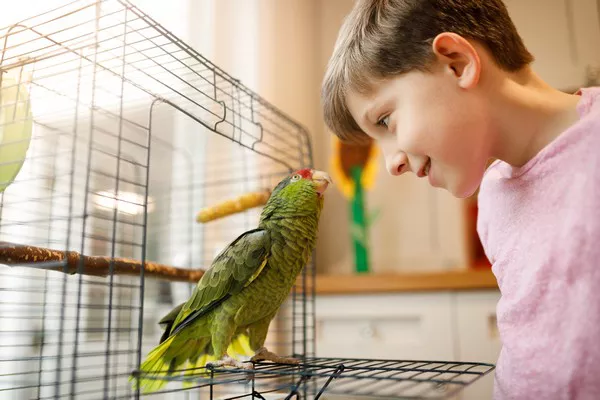Corn snakes (Pantherophis guttatus) are one of the most popular pet snake species due to their docile nature, attractive coloration, and relatively simple care requirements. Many snake enthusiasts are drawn to them because they tend to be low-maintenance and hardy compared to other reptile species. However, just like any living creature, corn snakes are susceptible to certain health issues if not properly cared for. Understanding whether corn snakes get sick easily requires knowledge of their general health needs, common illnesses they may encounter, and how to prevent health problems through good husbandry.
This article will provide an in-depth look at the factors that affect corn snake health, common diseases they may experience, and tips for keeping your corn snake healthy and thriving.
1. The Basics of Corn Snake Health
Corn snakes are native to the southeastern United States, and they thrive in warm, humid environments. They are non-venomous constrictors, meaning they subdue their prey by wrapping around it and squeezing rather than injecting venom. In the wild, they typically hunt small rodents and birds, and they can live anywhere from 15 to 20 years in captivity when provided with proper care.
Corn snakes are generally regarded as a “beginner-friendly” snake species, largely because they are not as prone to stress as other species and tend to handle captivity well. However, as with any pet, they can become ill if their environmental needs are not met or if they are exposed to pathogens.
2. What Factors Influence Corn Snake Health?
Before diving into the specific diseases that corn snakes may face, it’s important to understand what factors can influence their overall health. When these factors are maintained properly, your corn snake is less likely to fall ill.
Temperature and Humidity
Corn snakes are ectothermic, meaning they rely on external sources of heat to regulate their body temperature. In the wild, they typically inhabit temperate climates with moderate humidity levels, and their enclosures should reflect this. If the temperature and humidity are not properly regulated, corn snakes may develop health issues like respiratory infections, dehydration, or poor digestion.
Temperature: Corn snakes need a temperature gradient in their enclosure, with a warm side (between 80-85°F or 27-29°C) and a cooler side (between 70-75°F or 21-24°C). If the warm side is too hot or the cool side too cold, it can stress the snake and affect its immune system.
Humidity: Maintaining humidity levels between 40% and 60% is ideal for corn snakes. Too much humidity can lead to respiratory problems and skin shedding issues, while too little humidity can result in dehydration and difficulty shedding.
Diet and Nutrition
Corn snakes are carnivorous and thrive on a diet of appropriately-sized rodents. The health of your snake is significantly impacted by the quality of its diet. Feeding your corn snake rodents that are too large can cause obesity or digestive issues, while feeding them inadequate prey can result in malnutrition.
Proper feeding intervals and portion sizes are crucial. Baby corn snakes may need to eat every 5-7 days, while adults typically eat every 7-10 days. Providing a balanced diet rich in nutrients helps support the immune system and overall well-being.
Cleanliness and Hygiene
A clean enclosure is essential for a healthy corn snake. A dirty enclosure can quickly lead to the buildup of harmful bacteria and parasites, which can cause illness. This includes regularly cleaning the snake’s water dish, removing uneaten prey, and sanitizing the enclosure.
Stress and Handling
Corn snakes are generally hardy creatures that tolerate handling well, but they can still become stressed. Prolonged or improper handling, or introducing too many changes to their environment (e.g., frequent relocation, too many visitors, loud noises), can lower their immune response and make them more susceptible to illness.
3. Common Health Issues in Corn Snakes
Though corn snakes are typically hardy, they are still vulnerable to various health issues if their care is inadequate. The following are some of the most common diseases and conditions that can affect corn snakes.
Respiratory Infections
Respiratory infections are one of the most common health issues in corn snakes, especially in those that are kept in too-cold or too-damp environments. The symptoms of a respiratory infection in a corn snake can include:
- Wheezing or labored breathing
- Mucus or bubbles around the nostrils or mouth
- Loss of appetite
- Lethargy
These symptoms usually indicate a bacterial or viral infection that needs to be treated promptly. Respiratory infections are often caused by poor ventilation, improper humidity, or sudden temperature fluctuations. If untreated, they can lead to pneumonia, which can be fatal.
Prevention: Ensuring that your corn snake’s enclosure has proper ventilation, a correct temperature gradient, and appropriate humidity levels can help prevent respiratory infections. If you notice any of the above symptoms, it’s important to take your snake to a reptile vet immediately for diagnosis and treatment.
Shedding Problems (Dysecdysis)
Corn snakes shed their skin periodically as they grow. Shedding problems, known as dysecdysis, can occur if the snake’s environment is too dry or if it is not receiving proper care. The most common symptoms of shedding issues include:
- Retained eye caps (the transparent scales over the eyes)
- Patches of old skin still clinging to the body
- Incomplete or irregular shedding patterns
Causes: Dysecdysis is usually caused by improper humidity levels, insufficient hydration, or an inadequate temperature gradient. It can also be a sign of underlying health problems such as malnutrition or dehydration.
Prevention: To prevent shedding problems, ensure that your corn snake’s enclosure is kept at the proper humidity level (around 50-60%) and that it has access to a humid hide or water bowl. If your snake is having difficulty shedding, you can offer a shallow water bath or slightly increase the humidity to help facilitate the process.
Gastrointestinal Issues
Corn snakes are prone to gastrointestinal problems, especially if they are fed improperly sized prey or not given enough time to digest between feedings. Common gastrointestinal issues include:
- Regurgitation (vomiting)
- Constipation
- Diarrhea
Regurgitation is particularly concerning because it can be caused by stress, improper feeding, or even bacterial infections. If a snake regurgitates frequently, it can lead to weight loss, malnutrition, and dehydration.
Prevention: Feeding appropriately sized prey, providing ample time for digestion, and avoiding handling your snake for 24-48 hours after feeding can reduce the risk of gastrointestinal problems. If you notice that your snake is regurgitating its food, it’s important to rule out underlying health issues and consult a reptile vet.
Parasites and Internal Worms
Corn snakes can be infected with various types of internal parasites, including nematodes, tapeworms, and protozoa. These parasites are often contracted through eating infected prey or coming into contact with contaminated substrates.
Common symptoms of parasitic infections include:
- Weight loss
- Visible lumps in the belly area
- Vomiting
- Diarrhea
Prevention: The best way to prevent parasitic infections is by ensuring that your snake’s food is properly sourced and gut-loaded. Additionally, keeping the enclosure clean and avoiding the introduction of new, potentially infected prey can help reduce the risk.
If your snake shows signs of a parasitic infection, a vet can perform fecal tests and administer the appropriate treatment.
Mites and External Parasites
External parasites such as mites and ticks are common in pet snakes and can cause a variety of issues, including skin irritation, blood loss, and stress. Mites are small, often invisible to the naked eye, but they can be seen around the snake’s eyes, mouth, or underbelly.
Prevention: Regularly inspecting your snake for signs of mites and other external parasites is important. If you suspect your snake has mites, you may need to isolate it from other reptiles and treat it with a reptile-safe mite treatment.
4. How to Prevent Health Problems in Corn Snakes
Prevention is always the best way to keep your corn snake healthy. Here are several steps you can take to minimize the risk of illness:
Provide proper temperature and humidity levels. A well-maintained temperature gradient and appropriate humidity will keep your snake comfortable and reduce the risk of respiratory infections and shedding problems.
Feed a balanced diet. Ensure that your snake is fed the right type and size of prey, and feed it on a regular schedule to avoid obesity or malnutrition.
Maintain a clean environment. Regularly clean your snake’s enclosure, water dish, and accessories to prevent the buildup of harmful bacteria.
Limit stress. Handle your snake gently and only when necessary. Avoid excessive noise, temperature changes, and other factors that could cause stress.
Consult a reptile vet regularly. Regular health checkups with an experienced reptile veterinarian will help catch potential health problems early.
Conclusion
While corn snakes are generally hardy and do not get sick easily compared to other reptile species, they are not immune to health problems. Proper care, including maintaining the correct temperature, humidity, diet, and cleanliness, is essential to ensuring that your corn snake stays healthy. By following best practices and being vigilant for early signs of illness, you can significantly reduce the risk of your corn snake becoming sick.
If you are ever uncertain about your snake’s health or notice any unusual symptoms, it’s important to consult a qualified reptile veterinarian for professional advice. With proper care, your corn snake can live a long, healthy life, offering you years of enjoyment as a beloved pet.
Related Topics:

























